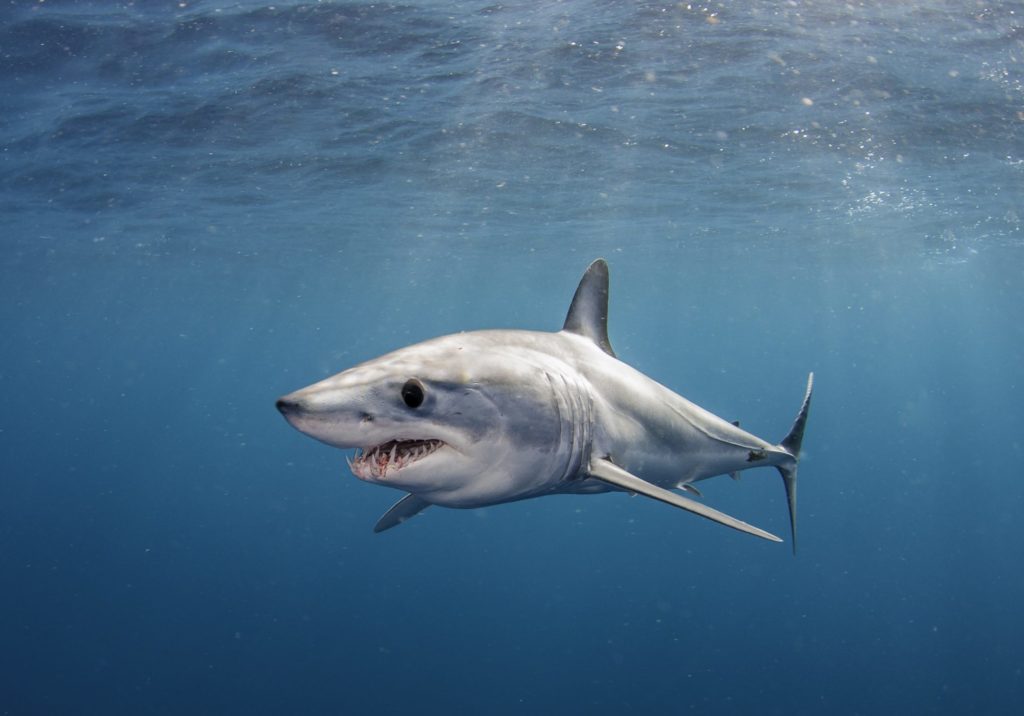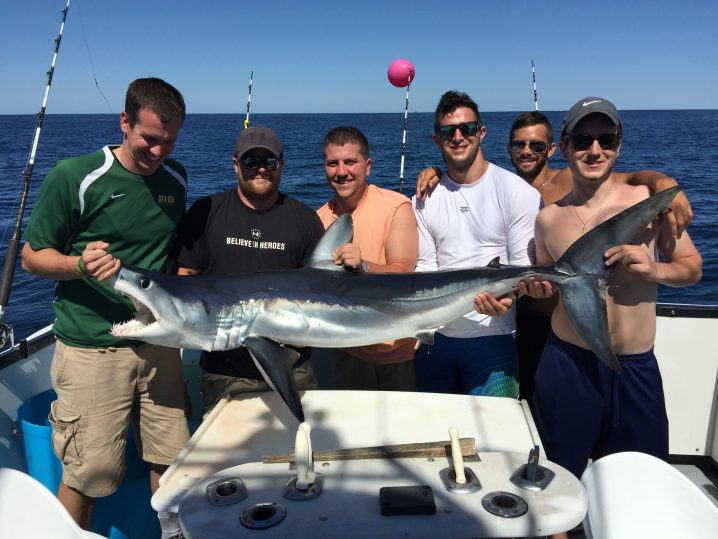The Shortfin Mako Shark is the deadliest fish in the sea. Every part of these apex predators is finely tuned for perfect hunting. They can swim faster, farther, and more relentlessly than any other Shark. They specialize in hunting other big game species. When hooked, Makos fight with an intelligence and ferocity that can frighten anglers into cutting their lines. In short, they’re the oceans’ ultimate predators.

Despite all of this, Mako numbers are dwindling. What makes these creatures special? Where do they live? And why are they under threat? Here’s all you need to know.
Shortfin vs. Longfin Mako Sharks
There are two species of Mako Shark, and they’re very, very different. Shortfin Mako are the species we’re focusing on today. They’re built for speed and power, specializing in taking down other alpha predators. They’re strong, aggressive, and eerily intelligent.
Longfin Makos are the opposite. These deep-water fish are masters of efficiency. They spend life in the slow lane, drifting through the ocean with minimal effort. Longfin Makos are still still incredibly capable hunters, but they don’t come close to their short-finned cousins.
Hot-Blooded Hunters

Mako Sharks come from the same family as Porbeagles and Great Whites. The thing that sets them apart from other Sharks is the fact that they’re warm-blooded. Makos heat up their blood in their core, red muscle. The warmth then pumps throughout their body, keeping them up to 35º F warmer than the water around them.
Why is this important? Several reasons. It lets Makos work their muscles harder and faster. It speeds up their digestion, giving them more energy for the day’s hunt. Their brain and eyes are also fed by a steady supply of hot blood. This keeps their minds and their eyesight sharp even in deep, near-freezing water. Add all this together and you get a strong, fast hunter that can adapt to any environment.
Marathon Migrators
Shortfin Makos need to adapt because they travel all over the world. Tagged fish often show up thousands of miles from where they were first caught. Mako hot spots are as varied as San Diego, Montauk, Cape Town, South Africa, and Exmouth, Australia. And these are just the fisheries we know about!
There’s a very good reason the Shortfin Mako Shark travels so far: they can’t stop. Literally. They need to keep moving to keep themselves warm, and they need to stay warm for their muscles to work properly. It’s a catch 22.
Luckily, Makos seem to know exactly when and where the bite is at its best. They tour the world gorging themselves on oily, energy-rich fish. On the East Coast, their top feasts are the Bluefish and Mackerel migrations. In California, they arrive with the Bigeye and Bluefin Tuna. Wherever you have fatty fish in big numbers, you’ll find Makos hot on their heels.
Bluewater Bullets

Shortfin Makos aren’t just long-distance runners. They’re also kings of the 100-meter sprint. Every part of their bodies is designed to give these Sharks speed. Their pointed noses cut through the water. Their tails are strong and symmetrical for maximum thrust. They even have special stabilizers called caudal keels to keep them on track at speed. Makos really are the sports cars of the ocean.
Granted, a lot of fish are fast. The thing that makes Makos special is the way their muscles work. They have two types of muscle: red muscle for long-distance swimming, and white muscle for sharp bursts of speed. They can cross an entire ocean without tiring out their hunting muscles. This means that, even after migrating 3,000 miles, they can still reach speeds of over 40 mph and jump a clear 30 feet out of the water as they attack their prey.
Big Game Specialists

“Why would any fish need to be this deadly?” you ask. It comes down to what they eat. Smaller Makos mainly feed on schools of oily fish. When they hit around 500 pounds, though, they undergo a transformation. Their teeth get thicker and tougher, and they start going after much bigger meals. Shortfin Makos are Billfish specialists.
Many an angler has hooked into a Marlin or a Swordfish, only to feel the line go limp and find the fish without its tail. This is the Mako’s signature move. They rocket up from the depths and bite through the bone, taking the tail clean off. Next, they bite off the bill to leave the fish defenseless. Large Makos have taken Swordfish weighing well over 500 pounds in the past.
Tactical Fighters

So Mako Sharks are strong, ferocious, and fearless. What could possibly top all that? Ask anyone who’s into Mako Shark fishing and they’ll all say the same thing: they’re clever. In fact, Makos are eerily intelligent at times. Before they bite, they often make a pass by the boat, weighing their odds and planning their attack. Once they’re hooked, they use every trick in the book to try and get away.
You may have seen videos of a Mako Shark jumping before. What you might not see is how they spin in the air and land on the line. They also circle the boat or swim around buoys when they’re hooked. It’s as if they know they’re attached to the boat and they’re trying to break the line.
When that doesn’t work, they straight up go for the boat. They bite it. They ram it. Sometimes, they even throw themselves onto the boat itself. Imagine hooking into a grander Mako, only to see it come flying through the sky and crashing onto the deck.
Terror of the Seas?

Are Makos a danger to humans? Not as much as you might think. There are only 10 recorded Mako attacks in history, according to the International Shark Attack File. They live too far offshore to come into contact with us much. Smaller, inshore species like Bulls and Tigers are responsible for most attacks on people. Makos are perfectly happy stealing our Swordfish once we’ve spent two hours fighting it.
Are we a danger to them? Definitely. They taste great and mature slowly, not a great combination in today’s oceans. On top of this, they regularly get caught in commercial nets and longlines intended for other species. Because of this Shortfin Mako Sharks are listed as an endangered species and NOAA is discussing changes to both commercial and recreational legislation.
Mako Sharks: Fish Worth Protecting
Shortfin Mako Sharks are one of the most impressive creatures on the planet. They’re tougher, smarter, and more deadly than any other fish, literally eating apex predators for breakfast.
More importantly, they’re a crucial part of our oceans’ ecology. If we lose them, we throw the entire food chain out of balance. Our advice is to consider tagging and releasing Makos if they’re healthy. Think of it as paying respect to the ocean’s ultimate predator.
What’s your favorite thing about Shortfin Mako Sharks? Have you ever caught one yourself? Drop us your thoughts and stories in the comments below, we’d love to hear from you!